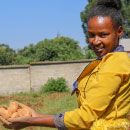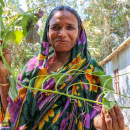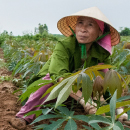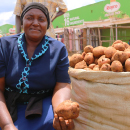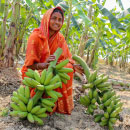Successful marketing of a perishable product like sweetpotato or banana requires a cooperative value chain in which goods and information can move freely and in a coordinated fashion.
Women and men participate at different points in these value chains, so a clear understanding of their needs, roles and responsibilities is required in order to design gender-responsive strategies to strengthen market chains in an equitable manner.
RTB, through its RTB-ENDURE project Expanding utilization of roots, tubers and bananas and reducing their post-harvest losses, implemented a Participatory Market Chain Approach (PMCA) with a gender lens to study market chains for sweetpotato and banana in Uganda. Both studies used a mix of single-sex focus group discussions and individual interviews to understand the perspectives of value chain actors.
Looking at the banana value chain, one of the striking challenges was a mismatch between the varieties grown by farmers and those demanded by consumers. Production of preferred varieties was limited by a lack of clean planting material at an affordable price and by weak linkages between farmers and larger markets.
Seed supply was identified as a business opportunity, especially for women, and so a low-cost seed multiplication technology, developed by the International Institute for Tropical Agriculture (IITA), was introduced to five women’s groups and five men’s groups (women find it easier to access seed from women’s groups and men from men’s groups). People in each group were trained to produce high-quality seed, which was then offered to group members in exchange for work such as fetching water, weeding and preparing planting material. When neighboring farmers saw how well the clean seed performed, they ordered some too, and groups initially ran out of planting material.

In response, one of the women’s groups decided to build a new multiplication facility using their own funds. Their commitment and enterprise resulted in a grant of USD 2000 from the local district councilor. While this was very helpful, the group realized it also needed to address the lack of water during the long dry season but the project, which offered access to funding and technical support, had ended. Linkages that the group had established with actors further along the value chain came to the rescue. The group was able to invest in a water tank, which eased the water shortage and ensured a continuing supply of preferred banana varieties in the market.
The gender lens in the PMCA allowed the women to identify and benefit from a series of innovations. In the course of implementing these, they enhanced their ability to negotiate and plan, and their overall self-esteem. Furthermore, they control the income that their new initiatives generate, further increasing their economic empowerment.
Sweetpotato has traditionally been grown for consumption in Uganda, and the market chain is not as well developed as that of banana. In order to plan effective interventions, the RTB-ENDURE project applied a gender-responsive mapping tool to describe how various links in the chain relied on women and men. For example, food production and roadside and market retail sales were almost exclusively the domain of women. Men undertook wholesale, brokerage and transport, and all the bicycle traders were men. Farms owned by men were a third larger than those owned by women, and yields were 60% higher, but almost all the labor on men’s farms was provided by women, who also had to take care of their own plots. Despite the fact that women are in fact responsible for about 60% of sweetpotato production, they have less access to market information and post-harvest technologies.
These insights on gendered dynamics in value chains will complement gender-responsive strategies for improving post-harvest management.


